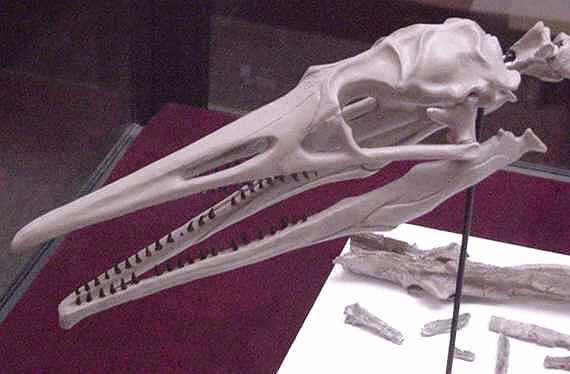Post by Infinity Blade on Nov 17, 2015 3:36:30 GMT 5
Ichthyornis dispar

Life restoration of Ichthyornis. © @ Anto09
Temporal range: Late Cretaceous (Turonian-Campanian: ~95-85Ma[1][2][6])
Scientific classification:
Life
Domain: Eukaryota
(unranked): Unikonta
(unranked): Opisthokonta
(unranked): Holozoa
(unranked): Filozoa
Kingdom: Animalia
Subkingdom: Eumetazoa
(unranked): Bilateria
Clade: Nephrozoa
Superphylum: Deuterostomia
Phylum: Chordata
Clade: Olfactores
Clade: Craniata
Subphylum: Vertebrata
Infraphylum: Gnathostomata
Clade: Eugnathostomata
Clade: Teleostomi
Superclass: Tetrapoda
Clade: Reptiliomorpha
Clade: Amniota
Class: Reptilia or Clade: Sauropsida
Clade: Eureptilia
Clade: Romeriida
Clade: Diapsida
Clade: Neodiapsida
Clade: Archelosauria
Clade: Archosauromorpha
Clade: Archosauriformes
Clade: Crurotarsi
Clade: Archosauria
Clade: Avemetatarsalia
Clade: Ornithodira
Clade: Dinosauromorpha
Clade: Dinosauriformes
Clade: Dinosauria
Order: Saurischia
Clade: Eusaurischia
Suborder: Theropoda
Clade: Neotheropoda
Clade: Averostra
Clade: Tetanurae
Clade: Orionides
Clade: Avetheropoda
Clade: Coelurosauria
Clade: Tyrannoraptora
Clade: Maniraptoriformes
Clade: Maniraptora
Clade: Pennaraptora
Clade: Paraves
Clade: Eumaniraptora
Clade: Averaptora
Clade: Avialae
Clade: Euavialae
Clade: Avebrevicauda
Clade: Pygostylia
Clade: Ornithothoraces
Clade: Euornithes
Clade: Ornithurae
Clade: †Enantornithes
Genus: †Ichthyornis
Species: †I. dispar
Ichthyornis ("fish bird") was a genus of volant enantornithe, an extinct clade of toothed birds. It lived in what was then the Western Interior Seaway of North America from the Turonian to the Campanian stages; ~95-85 million years ago. It was discovered in the Niobrara Chalk.[1]
Description:
Ichthyornis is believed to have occupied the same ecological niche as extant seabirds.[2] Size varies among the known specimens of the taxon[1], but the average specimen was ~24 centimeters long with a wingspan of ~43 centimeters (not counting the feathers).[2] Unlike any extant bird, Ichthyornis actually had (small) teeth in its beak. In the upper jaw, there were only teeth in the posterior region of the jaw while the lower jaw had teeth in all regions.

Skull of Ichthyornis.
The teeth were pointed, recurved backwards, lateromedially compressed, had sharp anterior and posterior edges, and lacked serrations.[1] The beak was also made of numerous, different pieces instead of one piece of keratin.[3] Ichthyornis earns its name from its biconcave, "fish"-like vertebrae.[4] It also would have been an excellent flier based upon the fact that its wing and breast bones are like those of modern birds.[5]
The clade that Ichthyornis belonged to, Enantornithes, went extinct at the very end of the Cretaceous period as a result of the K-Pg extinction event.

Skeleton of Ichthyornis.
References:
[1] "Morphology, phylogenetic taxonomy, and systematics of Ichthyornis and Apatornis (Avialae:Ornithurae)" (Julia A. Clarke, 2004).
[2] "Ichthyornis sp. (Aves:Ichthyornithiformes) from the lower Turonian (Upper Cretaceous) of western Kansas" (Shimada & Fernandes, 2006).
[3] "Marsh was right: Ichthyornis had a beak" (Lamb, 1997).
[4] oceansofkansas.com/ichthyornis.html
[5] "Bone microstructure of the diving Hesperornis and the volant Ichthyornis from the Niobrara Chalk of western Kansas" (Chinsamy et al., 1998).
[6] "Vertebrate Biostratigraphy of the Smoky Hill Chalk (Niobrara Formation) and the Sharon Springs Member (Pierre Shale)" (Carpenter, 2003).

Life restoration of Ichthyornis. © @ Anto09
Temporal range: Late Cretaceous (Turonian-Campanian: ~95-85Ma[1][2][6])
Scientific classification:
Life
Domain: Eukaryota
(unranked): Unikonta
(unranked): Opisthokonta
(unranked): Holozoa
(unranked): Filozoa
Kingdom: Animalia
Subkingdom: Eumetazoa
(unranked): Bilateria
Clade: Nephrozoa
Superphylum: Deuterostomia
Phylum: Chordata
Clade: Olfactores
Clade: Craniata
Subphylum: Vertebrata
Infraphylum: Gnathostomata
Clade: Eugnathostomata
Clade: Teleostomi
Superclass: Tetrapoda
Clade: Reptiliomorpha
Clade: Amniota
Class: Reptilia or Clade: Sauropsida
Clade: Eureptilia
Clade: Romeriida
Clade: Diapsida
Clade: Neodiapsida
Clade: Archelosauria
Clade: Archosauromorpha
Clade: Archosauriformes
Clade: Crurotarsi
Clade: Archosauria
Clade: Avemetatarsalia
Clade: Ornithodira
Clade: Dinosauromorpha
Clade: Dinosauriformes
Clade: Dinosauria
Order: Saurischia
Clade: Eusaurischia
Suborder: Theropoda
Clade: Neotheropoda
Clade: Averostra
Clade: Tetanurae
Clade: Orionides
Clade: Avetheropoda
Clade: Coelurosauria
Clade: Tyrannoraptora
Clade: Maniraptoriformes
Clade: Maniraptora
Clade: Pennaraptora
Clade: Paraves
Clade: Eumaniraptora
Clade: Averaptora
Clade: Avialae
Clade: Euavialae
Clade: Avebrevicauda
Clade: Pygostylia
Clade: Ornithothoraces
Clade: Euornithes
Clade: Ornithurae
Clade: †Enantornithes
Genus: †Ichthyornis
Species: †I. dispar
Ichthyornis ("fish bird") was a genus of volant enantornithe, an extinct clade of toothed birds. It lived in what was then the Western Interior Seaway of North America from the Turonian to the Campanian stages; ~95-85 million years ago. It was discovered in the Niobrara Chalk.[1]
Description:
Ichthyornis is believed to have occupied the same ecological niche as extant seabirds.[2] Size varies among the known specimens of the taxon[1], but the average specimen was ~24 centimeters long with a wingspan of ~43 centimeters (not counting the feathers).[2] Unlike any extant bird, Ichthyornis actually had (small) teeth in its beak. In the upper jaw, there were only teeth in the posterior region of the jaw while the lower jaw had teeth in all regions.

Skull of Ichthyornis.
The teeth were pointed, recurved backwards, lateromedially compressed, had sharp anterior and posterior edges, and lacked serrations.[1] The beak was also made of numerous, different pieces instead of one piece of keratin.[3] Ichthyornis earns its name from its biconcave, "fish"-like vertebrae.[4] It also would have been an excellent flier based upon the fact that its wing and breast bones are like those of modern birds.[5]
The clade that Ichthyornis belonged to, Enantornithes, went extinct at the very end of the Cretaceous period as a result of the K-Pg extinction event.

Skeleton of Ichthyornis.
References:
[1] "Morphology, phylogenetic taxonomy, and systematics of Ichthyornis and Apatornis (Avialae:Ornithurae)" (Julia A. Clarke, 2004).
[2] "Ichthyornis sp. (Aves:Ichthyornithiformes) from the lower Turonian (Upper Cretaceous) of western Kansas" (Shimada & Fernandes, 2006).
[3] "Marsh was right: Ichthyornis had a beak" (Lamb, 1997).
[4] oceansofkansas.com/ichthyornis.html
[5] "Bone microstructure of the diving Hesperornis and the volant Ichthyornis from the Niobrara Chalk of western Kansas" (Chinsamy et al., 1998).
[6] "Vertebrate Biostratigraphy of the Smoky Hill Chalk (Niobrara Formation) and the Sharon Springs Member (Pierre Shale)" (Carpenter, 2003).



